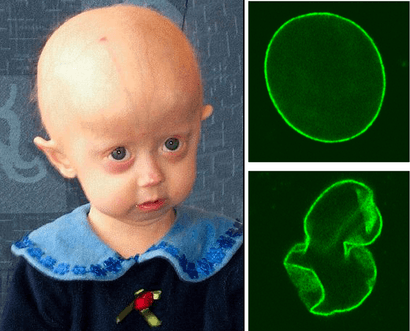Progeria facts for kids
Quick facts for kids Progeria |
|
|---|---|
| Synonyms | Hutchinson–Gilford progeria syndrome (HGPS), progeria syndrome |
 |
|
| A young girl with progeria (left). A healthy cell nucleus (right, top) and a progeric cell nucleus (right, bottom). | |
| Symptoms | Growth delay, short height, small face, hair loss |
| Complications | Heart disease, stroke, hip dislocations |
| Usual onset | 9–24 months |
| Causes | Genetic |
| Diagnostic method | Based on symptoms, genetic tests |
| Similar conditions | Hallermann–Streiff syndrome, Gottron's syndrome, Wiedemann–Rautenstrauch syndrome |
| Treatment | Mostly symptomatic |
| Medication | Lonafarnib |
| Prognosis | Average age of death is 13 years |
| Frequency | Rare: 1 in 18 million |
Progeria is a very rare genetic disorder. It makes a person's body show signs of aging much faster than normal. People with progeria are born looking like typical babies. But by their first or second birthday, they start to look like they are getting old very quickly. This condition is also known as Hutchinson–Gilford progeria syndrome (HGPS).
The word progeria comes from two Greek words. "Pro" means "before" or "premature". "Gēras" means "old age". So, progeria means "premature old age."
Contents
What is Progeria?
Progeria is a type of genetic disorder. This means it is caused by a change in a person's DNA. It is an "autosomal dominant" condition. This means only one copy of a changed gene is needed for the condition to appear.
People with progeria usually live to their mid-teens or early twenties. Scientists are very interested in progeria. Studying it might help us understand more about the normal process of aging.
How Does Progeria Happen?
Progeria happens because of a new mutation (a change) in a specific gene. This change usually happens by chance. It is very rarely passed down from parents to children. This is because people with progeria often do not live long enough to have children.
Signs and Symptoms
Children with progeria start showing signs of aging early. These signs usually appear between 9 and 24 months old.
- They grow slowly and are shorter than other kids their age.
- They often have a small face and a small jaw.
- They lose their hair, including their eyelashes and eyebrows.
- Their skin can become thin and wrinkled.
- They might have problems with their joints, like hip dislocations.
The most serious problems are often related to the heart. Children with progeria can develop heart disease or have a stroke. These are the main causes of death for people with the condition.
History of Discovery
Progeria was first described in 1886 by a doctor named Jonathan Hutchinson. Another doctor, Hastings Gilford, described it independently in 1897. Because of their work, the condition was later named Hutchinson–Gilford progeria syndrome.
Images for kids
See also
 In Spanish: Progeria para niños
In Spanish: Progeria para niños

